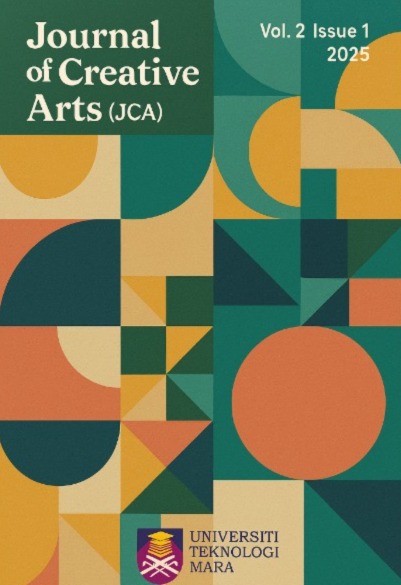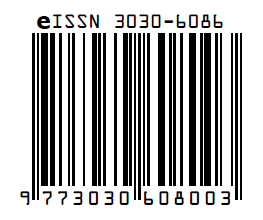Sacred Tone: The Spiritual and Psychoacoustic Dimensions of the Arabic Maqāmāt
DOI:
https://doi.org/10.24191/jca.v2i1.5042Keywords:
Maqamat, Psychoacoustics, Music Therapy, Sacred Music, Microtonality, EthnomusicologyAbstract
Arabic maqamat (singular: maqam) form the foundational modal system of traditional Arabic music, characterized by intricate microtonal structures and distinct melodic progressions. Historically, maqamat have been deeply intertwined with Islamic spirituality, mystical traditions, and music therapy, functioning as a bridge between the physical and metaphysical realms (Wright, 1995a). This study explores the psychoacoustic, spiritual, and therapeutic dimensions of maqamat, focusing on their role in Islamic ritual, Sufi practices, and contemporary sound healing. By integrating insights from ethnomusicology, music theory, and cognitive science, this research seeks to understand how maqamat induce emotional and transcendental states, examining their healing properties and neurological impact (Farmer, 1931; Feldman, 1990). The study employs a historical and theoretical analysis, supplemented by existing empirical research on music and cognition, to illustrate the enduring sacred and emotional power of maqamat.
References
D’Erlanger, R. (1930). La musique arabe. Librairie Orientaliste Paul Geuthner.
During, J. (1997). The spirit of sounds: The unique art of Ostad Elahi. Cornwall Books. Farmer, H. G. (1930). A history of Arabian music to the XIIIth century. Oxford University
Press.
Farmer, H. G. (1931). Studies in Oriental Musical Instruments. London.
Farraj, J., & Shumays, S. A. (2019). Inside Arabic Music: Arabic Maqām Performance and Theory in the 20th Century. Oxford University Press.
Faruqi, L. (1981). Music of the Arabs. Amana Publications.
Feldman, W. (1990). Cultural authority and authenticity in the Turkish repertoire. Asian Music, 22(1), 73-111.
Frishkopf, M. (2018). Music, Sufism, and spirituality in the Muslim world. Routledge.
Frishkopf, M., & Spinetti, F. (Eds.). (2018). Music, sound, and architecture in Islam. University of Texas Press.
Gautier, F. (2013). Music and healing in the Muslim world. Oxford University Press.
Ghrab, A. (2009). Commentaire anonyme du Kitāb al-adwār : édition critique, traduction et présentation des lectures arabes de l’œuvre de Ṣafī al-Dīn al-Urmawī. Université Paris- Sorbonne.
Gutas, D. (2001). Avicenna and the Aristotelian tradition: Introduction to reading Avicenna’s philosophical works. Brill.
Jankowsky, R. C. (2010). Stambeli: Music, trance, and alteration in Tunisia. University of Chicago Press.
Jourdain, R. (1997). Music, the brain, and ecstasy: How music captures our imagination.
William Morrow.
Koelsch, S. (2010). Towards a neural basis of music-evoked emotions. Trends in Cognitive Sciences, 14(3), 131–137. https://doi.org/10.1016/j.tics.2010.01.002
Levitin, D. J. (2006). This is your brain on music: The science of a human obsession. Dutton. Lewisohn, L. (1997). The Sacred Music of Islam: Sama’ in the Persian Sufi Tradition. British
Journal of Ethnomusicology, 6(1), 1-33.
Lewisohn, L. (2008). The heritage of Sufism: Classical Persian Sufism from its origins to Rumi. Oneworld Publications.
Lewisohn, L. (Ed.). (2008). The philosophy of ecstasy: Rumi and the Sufi tradition. World Wisdom.
Marcus, S. (2007). Music in Egypt: Experiencing Music, Expressing Culture. Oxford University Press.
Nelson, K. (2001). The art of reciting the Quran. University of Texas Press. Patel, A. D. (2008). Music, language, and the brain. Oxford University Press.
Powers, H. S., & Widdess, R. (2001). Raga. The New Grove Dictionary of Music and Musicians.
Racy, A. J. (2003). Making Music in the Arab World: The Culture and Artistry of Tarab. Cambridge University Press.
Rasmussen, A. K. (2010). Women, the recited Qur’an, and Islamic music in Indonesia.
University of California Press.
Rouget, G. (1985). Music and trance: A theory of the relations between music and possession.
University of Chicago Press.
Särkämö, T., Tervaniemi, M., Laitinen, S., Forsblom, A., Soinila, S., Mikkonen, M., Autti, T., Silvennoinen, H. M., Erkkilä, J., Laine, M., & Peretz, I. (2008). Music listening enhances
cognitive recovery and mood after middle cerebral artery stroke. Brain, 131(3), 866– 876. https://doi.org/10.1093/brain/awn013
Schimmel, A. (1975). Mystical Dimensions of Islam. University of North Carolina Press. Shannon, J. (2003). Sultans of spin: Sufism and the origins of modern musical aesthetics.
University of Chicago Press.
Shannon, J. H. (2015). Performing al-Andalus: Music and nostalgia across the Mediterranean.
Indiana University Press.
Shiloah, A. (1995). Music in the World of Islam: A Socio-Cultural Study. Wayne State University Press.
Signell, K. (1977). Makam: Modal practice in Turkish art music. University of Washington Press.
The Aga Khan Music Programme. (n.d.). Maqām and Global Modal Traditions. Retrieved from www.akdn.org/music
The Arab Music Archiving and Research (AMAR) Foundation. (n.d.). Online maqām recordings and historical analysis. Retrieved from www.amar-foundation.org
Touma, H. (1996). The Music of the Arabs. Amadeus Press.
Urkevich, L. (2015). Music and traditions of the Arabian Peninsula: Saudi Arabia, Kuwait, Bahrain, and Qatar. Routledge.
Urkevich, L. (2021). Music and traditions of the Arabian Peninsula: Sound, heritage, and society. Routledge.
Wright, O. (1978). The modal system of Arab and Persian music. Oxford University Press. Wright, O. (1995a). The Modal System of Arab and Persian Music, AD 1250-1300. Oxford
University Press.
Zonis, E. (1973). Classical Persian music: An introduction. Harvard University Press.
Downloads
Published
How to Cite
Issue
Section
License
Copyright (c) 2025 Raja Zulkarnain Raja Yusof

This work is licensed under a Creative Commons Attribution-NonCommercial 4.0 International License.




